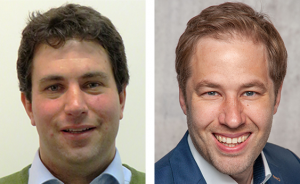
Prof. Knut Müller-Caspary and Dr. Thomas Lunkenbein
e-conversion attracts more and more top scientists: We warmly welcome two new members, Prof. Knut Müller-Caspary and Dr. Thomas Lunkenbein!
Our cluster is getting reinforcement by two young and highly skilled scientists:
Prof. Knut Müller-Caspary is a specialist in multidimensional Transmission Electron Microscopy (TEM). Within his scientific career path at EMAT in Antwerp, RWTH Aachen and Forschungszentrum Jülich he developed methodologies for so-called momentum-resolved scanning TEM and ultrafast electron detection. With these tools, the scientists can dive into materials to the subatomic scale. For instance, they are able to map and measure electrical charges and thereby analyze the structural, chemical and electrical properties of materials. These quantities are key components for the understanding of optoelectronic processes, e.g., in solar cells, or site-specific catalyst performance. Since September 2021 Knut Müller-Caspary is professor at the Chemistry Department of the LMU Munich.
With Dr. Thomas Lunkenbein e-conversion is enriched with a second expert on Electron Microscopy. He studied chemistry in Bayreuth where he also did his PhD. In 2012 Thomas Lunkenbein moved as Postdoctoral Fellow to the Electron Microscopy Group at the Fritz Haber Institute in Berlin one of the four external e-conversion institutions. Since 2018 he leads the group himself. One focus of his research is to gain knowledge on selected materials and catalysts relevant for energy conversion. In particular, the group uses a variety of state-of-the art analytical electron microscopes to guide the synthesis of new catalysts as well as to monitor structural developments induced under catalytic conditions down to the atomic level.
Both groups complement each other substantially with respect to methodology, equipment and applications expertise, especially bridging between ex-situ, in-situ and in-operando characterization down to the atomic scale.
